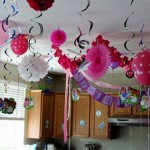How to Open a Home Decor Business
The home decor industry presents a compelling opportunity for individuals with a passion for design and an entrepreneurial spirit. Opening a home decor business, however, requires careful planning, market research, and a dedicated approach to establishing a brand and attracting customers. This article details the essential steps involved in launching a successful home decor business, encompassing aspects from initial conception to ongoing operations.
Developing a Business Plan
The foundation of any successful business lies in a comprehensive business plan. This document serves as a roadmap, outlining the business's objectives, strategies, and financial projections. A well-structured business plan is not only crucial for internal guidance but also essential when seeking funding from investors or lenders.
The initial step involves defining the business's niche. The home decor market is vast and diverse, encompassing various styles, product categories, and target audiences. Identifying a specific niche allows for focused marketing efforts and the development of specialized expertise. Examples of niches include modern minimalist decor, vintage and antique finds, sustainable and eco-friendly products, or decor catering to specific demographics like families with young children or pet owners.
Market research is paramount. This involves analyzing the target market, understanding consumer preferences, identifying competitors, and assessing market trends. Gathering data through surveys, online research, and competitor analysis provides valuable insights into the demand for specific products, pricing strategies, and effective marketing channels. Understanding local demographics, income levels, and design preferences within the target geographic area is also vital.
The business plan should also outline the company's mission statement, defining its core values and purpose. This statement should reflect the brand's identity and guide all business decisions. Clear objectives, both short-term and long-term, should be established, providing measurable goals for the business to strive towards. Measurable objectives could include sales targets, customer acquisition goals, and brand awareness metrics.
A detailed financial plan is crucial. This section should include start-up costs, projected revenue, expense forecasts, and profitability analysis. Accurately estimating expenses such as rent, utilities, inventory, marketing, and salaries is essential for determining the required funding and establishing a sustainable pricing strategy. Projecting revenue and profitability requires a realistic assessment of sales potential based on market research and pricing strategy.
The business plan should also include a description of the management team, highlighting their experience and expertise. This section is particularly important when seeking funding, as investors and lenders will assess the team's ability to successfully execute the business plan. An organizational chart outlining roles and responsibilities can further demonstrate the structure and efficiency of the business.
Establishing a Brand and Sourcing Products
Creating a strong brand identity is vital for differentiating the home decor business in a competitive market. The brand encompasses the business's name, logo, visual identity, and overall messaging. A consistent brand image across all marketing channels helps to build recognition and trustworthiness.
Developing a unique selling proposition (USP) is crucial for attracting customers. This USP articulates what makes the business different from its competitors. It could be a focus on handcrafted items, personalized service, unique design concepts, or a commitment to sustainable sourcing. Emphasizing the USP in all marketing materials helps to resonate with the target audience.
Establishing a strong online presence is essential in today's digital age. A professional website serves as the primary online storefront, showcasing products, providing information about the business, and enabling online sales. High-quality product photography and detailed descriptions are necessary to attract and convert online visitors. Search engine optimization (SEO) techniques should be employed to improve the website's visibility in search engine results.
Social media marketing is an invaluable tool for reaching a wider audience and engaging with potential customers. Platforms like Instagram, Pinterest, and Facebook are particularly effective for visually showcasing home decor products and creating a community around the brand. Consistent posting of engaging content, such as inspirational images, design tips, and product spotlights, can help to build brand awareness and drive traffic to the website.
Sourcing high-quality products is critical for maintaining customer satisfaction and building a positive reputation. Several options exist for sourcing home decor items, including wholesale suppliers, manufacturers, artisans, and importers. Attending trade shows and industry events provides opportunities to discover new products, network with suppliers, and stay informed about market trends.
Negotiating favorable terms with suppliers is essential for maximizing profitability. This involves comparing prices from multiple suppliers, negotiating payment terms, and establishing long-term relationships. Building strong relationships with suppliers can lead to preferential pricing, access to exclusive products, and reliable delivery schedules. It is crucial to prioritize ethical and sustainable sourcing practices to align with consumer values and build a socially responsible brand.
Operational Considerations and Marketing Strategies
Efficient operations are crucial for running a successful home decor business. This involves establishing a streamlined inventory management system, implementing effective order fulfillment processes, and providing excellent customer service.
Inventory management is essential for avoiding stockouts and minimizing storage costs. A robust inventory management system tracks inventory levels, monitors sales trends, and automates the reordering process. Implementing a just-in-time inventory system can help to reduce storage costs by ordering products only when they are needed.
Order fulfillment involves processing orders, packaging items, and shipping them to customers. Streamlining this process ensures timely delivery and minimizes errors. Offering various shipping options and providing tracking information enhances the customer experience. For businesses with a physical storefront, creating an inviting and well-organized display is critical for attracting customers and facilitating sales.
Providing exceptional customer service is vital for building customer loyalty and generating positive word-of-mouth referrals. Responding promptly to inquiries, resolving complaints efficiently, and offering personalized assistance can significantly improve customer satisfaction. Implementing a customer relationship management (CRM) system can help to track customer interactions, manage customer data, and personalize marketing efforts.
Developing a comprehensive marketing strategy is crucial for attracting customers and driving sales. This strategy should encompass both online and offline marketing channels. Email marketing is an effective way to communicate with customers, promote new products, and offer exclusive deals. Building an email list through website sign-ups and social media promotions allows for targeted marketing campaigns.
Search engine marketing (SEM) involves using paid advertising to improve a website's visibility in search engine results. Platforms like Google Ads allow you to target specific keywords and demographics, ensuring that your ads are shown to the most relevant audience. Pay-per-click (PPC) advertising can be an effective way to drive traffic to your website and generate leads.
Offline marketing strategies, such as participating in local craft fairs and home shows, can provide opportunities to reach potential customers and showcase products in person. Partnering with interior designers and real estate agents can also be an effective way to generate referrals and reach a wider audience. Developing targeted advertising campaigns in local publications or community newsletters can also raise brand awareness.

How To Open A Home Décor The Definitive Guide Hana Retail

How To Start Your Home Decor Business Oppein

How To Start Own Home Decor Business In

Launch Your Home Decor Business A Complete Guide For Beginners

At Home Set To Open Amid Crisis In Furnishings Rockland County Business Journal

J B Home Decor Gifts

Interior Design Styles 101 The Ultimate Guide To Decorating In 2025 Decorilla

Home Decor Website App Development In Surat Videe Infotech

Closer Look Como Business Times

Business Notes Home Decor Serena Lily To Open In Bethesda Row Next Year
Related Posts







